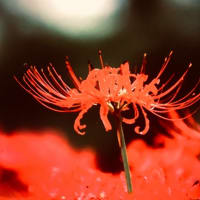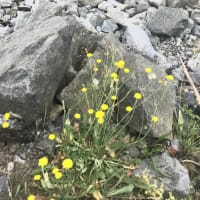
今日のタイトルは村上春樹の小説の中で特に好きな”海辺のカフカ”を捩ったものです。
Today’s title, “Dandelions on the Shore” is a twist from one of my most favorite Murakami’s novels, “Kafka on the Shore.”
最近ここバンクーバーでは何故かタンポポを見かけなくなりました。
For several years, I haven’t seen dandelions here in Vancouver.
ところが我が家の近くの海辺に逞しく育っているタンポポを見つけました。
However, I have found a group of dandelions growing on the rocky shore near my home.
こんなに岩がゴロゴロしたほとんど土がない岸壁でもしっかりと成長しています。
They seem to be growing so vigorously on the rocky shore with almost no soil.
タンポポといえば今までは雑草の中でも一番の嫌われ者でした。
Dandelions have been the most hated of all weeds so far.
特に綺麗に整えられた芝生にタンポポが一輪でも咲き始めると大急ぎで根こそぎに抜き去らなくてはなりません。
Especially when even a single dandelion begins to grow on a beautiful lawn, it must be quickly removed to the roots.
上の写真からもわかりますが、北米のタンポポはヒョロんと首が長く、その根は驚くほど強く長いのです。
As you can see from the photo above, North American dandelions have very long and slender stems and surprisingly strong and long roots.
ところでタンポポの英語名はDandelionですが、語源をごぞんじですか?
Now, do you know where the name “Dandelion” comes from?
英語のほとんどの語源がラテン語かギリシャ語になっていますが、この場合はラテン語です。
Most of the English words come from Latin or Greek, and in this case it is from Latin.
中世ラテン語からフランス語のdent de lion(ライオンの歯)を経て英語のdandelionになったようです。
It is said that the English word "Dandelion" originally come from medieval Latin, then through the French word "Dent de lion" which literally means "Teeth of Lion."
これはタンポポの葉がライオンの歯に似ているからとのことですが、
This is because the dandelion leaves resemble lion's teeth.
日本語の“歯”と”葉”が同音異義語*なのは偶然でしょうか?
I’m wondering if it’s a mere coincidence that the Japanese words “tooth(ha)” and “leaf(ha)” are
homophones?**
*同音異義語homophone(ギリシャ語源homo同じ・phone音)
**homophones (homophone comes from Greek words, homo(same) phone(sound)
Today’s title, “Dandelions on the Shore” is a twist from one of my most favorite Murakami’s novels, “Kafka on the Shore.”
最近ここバンクーバーでは何故かタンポポを見かけなくなりました。
For several years, I haven’t seen dandelions here in Vancouver.
ところが我が家の近くの海辺に逞しく育っているタンポポを見つけました。
However, I have found a group of dandelions growing on the rocky shore near my home.
こんなに岩がゴロゴロしたほとんど土がない岸壁でもしっかりと成長しています。
They seem to be growing so vigorously on the rocky shore with almost no soil.
タンポポといえば今までは雑草の中でも一番の嫌われ者でした。
Dandelions have been the most hated of all weeds so far.
特に綺麗に整えられた芝生にタンポポが一輪でも咲き始めると大急ぎで根こそぎに抜き去らなくてはなりません。
Especially when even a single dandelion begins to grow on a beautiful lawn, it must be quickly removed to the roots.
上の写真からもわかりますが、北米のタンポポはヒョロんと首が長く、その根は驚くほど強く長いのです。
As you can see from the photo above, North American dandelions have very long and slender stems and surprisingly strong and long roots.
ところでタンポポの英語名はDandelionですが、語源をごぞんじですか?
Now, do you know where the name “Dandelion” comes from?
英語のほとんどの語源がラテン語かギリシャ語になっていますが、この場合はラテン語です。
Most of the English words come from Latin or Greek, and in this case it is from Latin.
中世ラテン語からフランス語のdent de lion(ライオンの歯)を経て英語のdandelionになったようです。
It is said that the English word "Dandelion" originally come from medieval Latin, then through the French word "Dent de lion" which literally means "Teeth of Lion."
これはタンポポの葉がライオンの歯に似ているからとのことですが、
This is because the dandelion leaves resemble lion's teeth.
日本語の“歯”と”葉”が同音異義語*なのは偶然でしょうか?
I’m wondering if it’s a mere coincidence that the Japanese words “tooth(ha)” and “leaf(ha)” are
homophones?**
*同音異義語homophone(ギリシャ語源homo同じ・phone音)
**homophones (homophone comes from Greek words, homo(same) phone(sound)




















※コメント投稿者のブログIDはブログ作成者のみに通知されます